WE HAVE
Top Value For You
Sign up for Travelviet VIP membership to enjoy special offers.
Explore the history, culture, people and breathtaking landscape of Vietnam on the Travelviet app
Download the Travelviet app
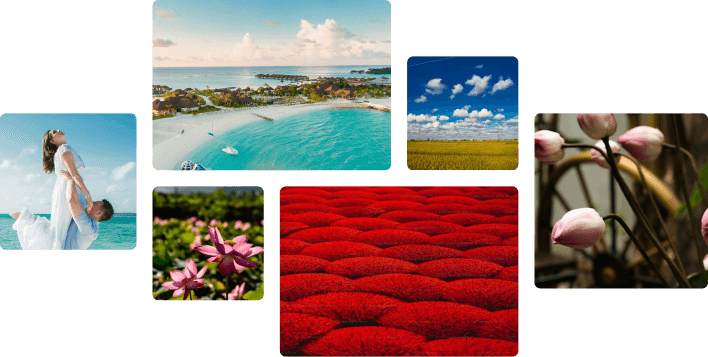
Ba Ria Vung Tau not only owns beautiful beaches, delicious specialties... but it also owns famous historical relics that have existed for hundreds of years. Currently, Vung Tau owns 48 historical relics, including 28 national relics, 1 special national relic and 19 provincial relics. Let's learn with 36S Travel about the famous historical relics in Ba Ria Vung Tau in this article.
15+ famous historical sites in Ba Ria Vung Tau attract tourists to visit
List of historical relics in Ba Ria Vung Tau will let you discover more cultural values and heroic history of the Vietnamese people. Do not miss it!
Vo Thi Sau Memorial House
Vo Thi Sau Memorial House in Con Dao is a place to preserve and honor the memories of the legendary heroine. Famous for its sacredness, Vo Thi Sau's tomb is the destination of many people who visit at the beginning of the year and return at the end of the year to "pay their respects".

Vo Thi Sau Memorial House - Monument to the indomitable hero in Vung Tau
In addition, in Dat Do town, visitors can visit Vo Thi Sau temple, where there is a 7m high bronze statue, depicting the leisurely image of Ms. Sau when going to the execution ground. The statue is located in the middle of an airy campus, fragrant with magnolia flowers, lekima and porcelain flowers. Here, visitors can not only pay their respects but also visit, admire the artifacts and learn about the brave life of the heroine.
Artillery field and large mountain mine bunker
The mine bunker on Nui Lon was built in 1944 by the Japanese fascists as a warehouse for naval weapons. During World War II, Japan occupied Vung Tau and established many underground bunkers, including a mine bunker on Nui Lon. Although small, the mine tunnel was built extremely elaborately and thoroughly. After the war ended, the allies removed the weapons and buried them in mine bunkers.
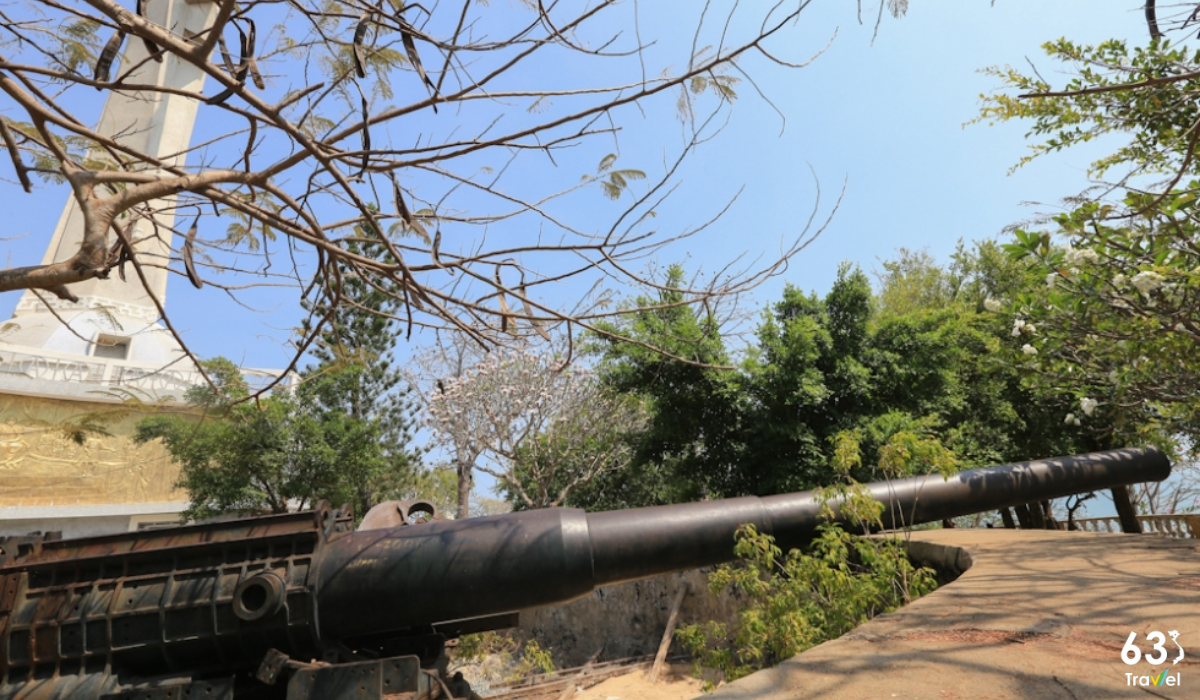
The largest ancient artillery battle in Indochina is in Vung Tau
The resilient fighting spirit of our people and soldiers has led to many raids into bunkers to steal enemy weapons to serve the army's fighting purposes. The raids on the Nui Lon mine bunker were the most impressive victories of Vung Tau's army and people in the resistance war against the French and Japanese.
On August 4, 1992, the state recognized and ranked the Ancient Cannon Battlefield Relic and Nui Lon Mine Tunnel as a national historical relic, recognizing the great contributions of Vung Tau's military and people.
Con Dao Prison Revolutionary Historical Relic Area
When coming to Con Dao, in addition to visiting Vo Thi Sau's grave, tourists often visit Con Dao prison - a special national monument ranked in 2012. Con Dao prison, often called "hell on earth". space", famous for its "tiger cage" system - the harshest place of solitary confinement.
With a space of only 5m², prisoners are shackled and have to lie on a damp, unsanitary cement floor. Built by the French colonialists to detain especially dangerous prisoners, Con Dao prison became a place to detain and torture thousands of political prisoners during the resistance war against France and the United States.
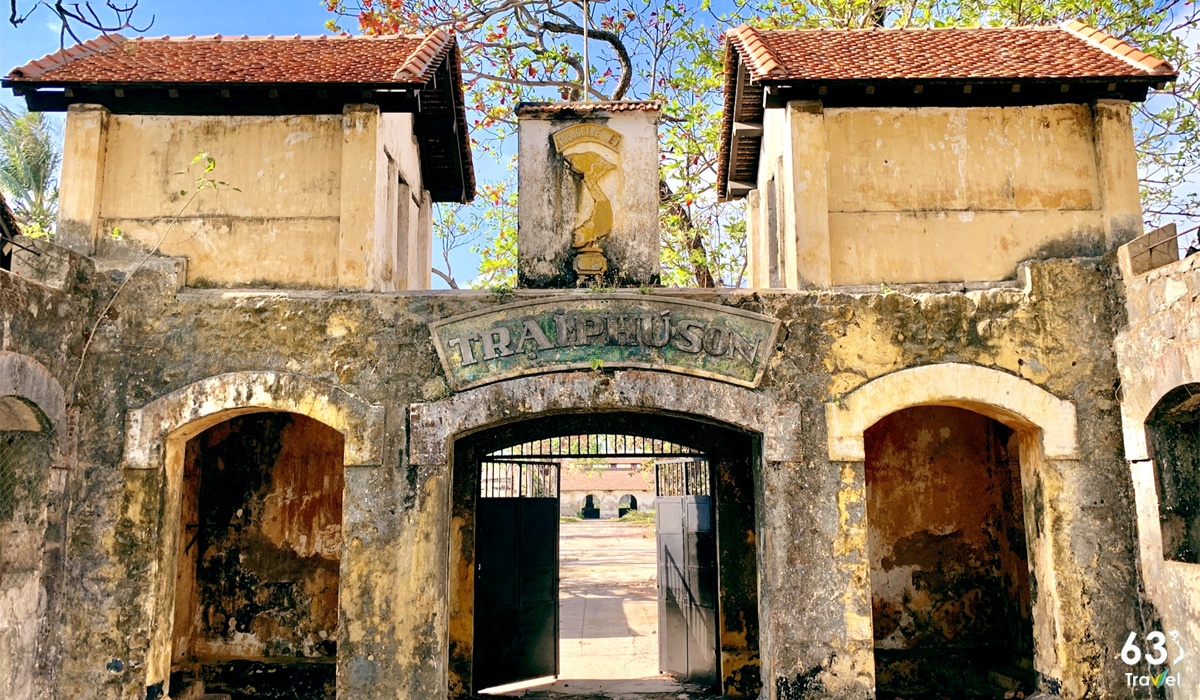
Visit Con Dao prison and witness "hell on earth"
On an area of 52km², the prison system includes 11 detention areas, including Phu Hai Prison, Phu Son Prison and many other camps. The brutal forms of torture here, such as throwing lime powder, pouring dirty water and being exposed to the sun and rain, have turned Con Dao prison into a living testament to the cruelty of the colonial regime.
Currently, this monument attracts thousands of tourists to better understand the hardships that revolutionary soldiers went through. With great historical value, Con Dao prison was recognized as a special national historical site on May 10, 2012.
Shakyamuni Buddha Monument
Located on the northern slope of Big Mountain, the Shakyamuni Buddha Monument stands out with the statue of Shakyamuni Buddha sitting quietly in a meditating position, on a campus of about 28 hectares. Around 1340, Mr. Le Quang Vinh and Venerable Narada Maha Thera explored this pristine land and decided to build a temple at the foot of the mountain, naming it Thien Lam Tu. However, Venerable Narada Maha Thera proposed building a large stupa on the mountainside in honor of Shakyamuni Buddha.
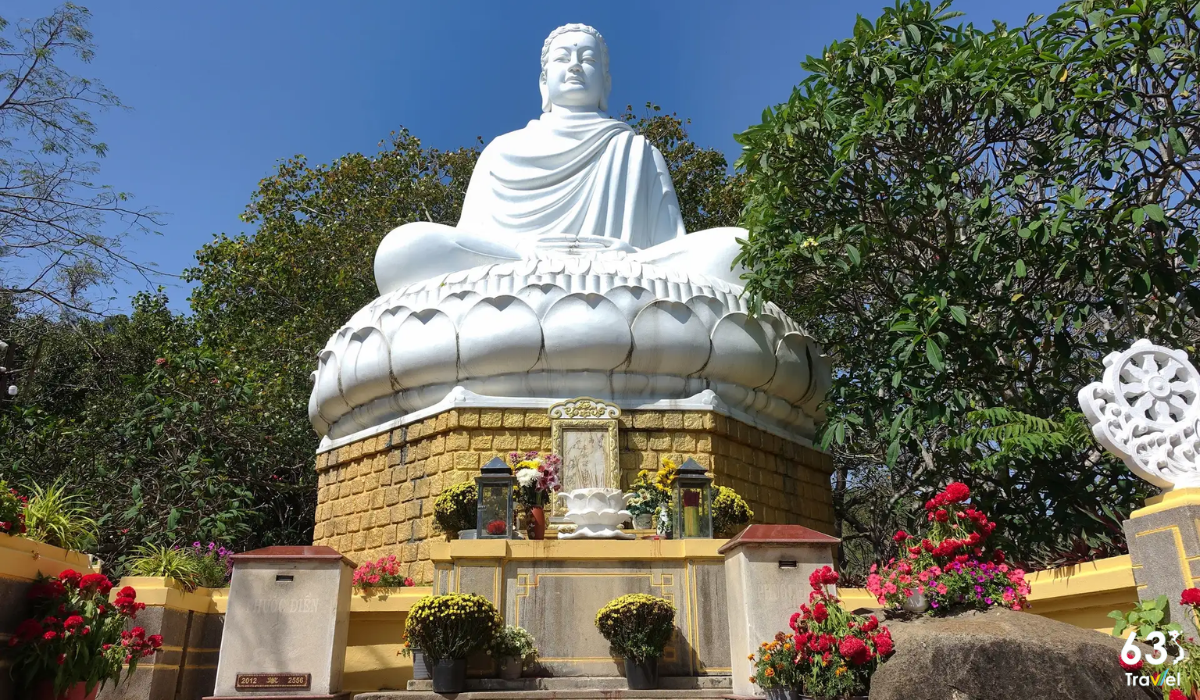
Shakyamuni Buddha Dai Vung Tau - outstanding Buddhist architectural complex
With enthusiastic support from the Southern Buddhist community, construction of the Shakyamuni Buddha Temple began on June 4, 1361. After 13 months of construction, on March 9 and 10, 1363, the project was inaugurated, including a Buddha statue and a monumental stupa of relics. Shakyamuni Buddha has quickly become a prominent destination in Vung Tau, attracting the admiration of many tourists and Buddhists.
>> Reference: The road between the golden fields in Vung Tau causes a fever because it is as beautiful as a cartoon
Bach Dinh historical site
The Bach Dinh relic site is a special example of European architecture of the late 19th century in Vietnam. Initially built during the reign of King Minh Mang as a fortress to control the Can Gio seaport, Bach Dinh was later destroyed by the French colonialists and reconstructed into a luxurious mansion for high-ranking figures such as Toan. Indochina ruler and Emperor Bao Dai.
From 1307 - 1316, this place also became the place of exile for former Emperor Thanh Thai, before being used as a resort for Emperor Bao Dai and Queen Nam Phuong from 1334. After 1375, Bach Dinh transformed into a resort. tourist destination and quickly became a prominent historical site of Vung Tau.
Bach Dinh was built at an altitude of about 27m above sea level, with a three-storey design: basement for cooking, ground floor for events and upstairs for rest. Visitors can approach the relic through two paths: one is a winding path in the middle of a forest of porcelain trees, and the other is 146 ancient stairs.
Currently, Bach Dinh is not only a national historical relic but also a museum displaying many precious artifacts, attracting a large number of visitors. With its cultural and historical values, the Bach Dinh relic site was recognized on August 4, 1392.
Linh Son Pagoda Relics "Linh Son Co Pagoda"
Linh Son Co Tu (also known as Golden Buddha Pagoda) is one of the oldest and most famous pagodas in Vung Tau, notable for its giant Golden Buddha statue. The pagoda was honored in the Top 100 typical spiritual tourist destinations of Vietnam and has been recognized by the State as a National Cultural and Historical Monument.
The pagoda has a long history, starting from when it was built on the slope of Nho Mountain. However, in 1919, when the French colonialists re-planned the area to build a lighthouse, the pagoda was relocated to the foot of the mountain with the help of villagers.
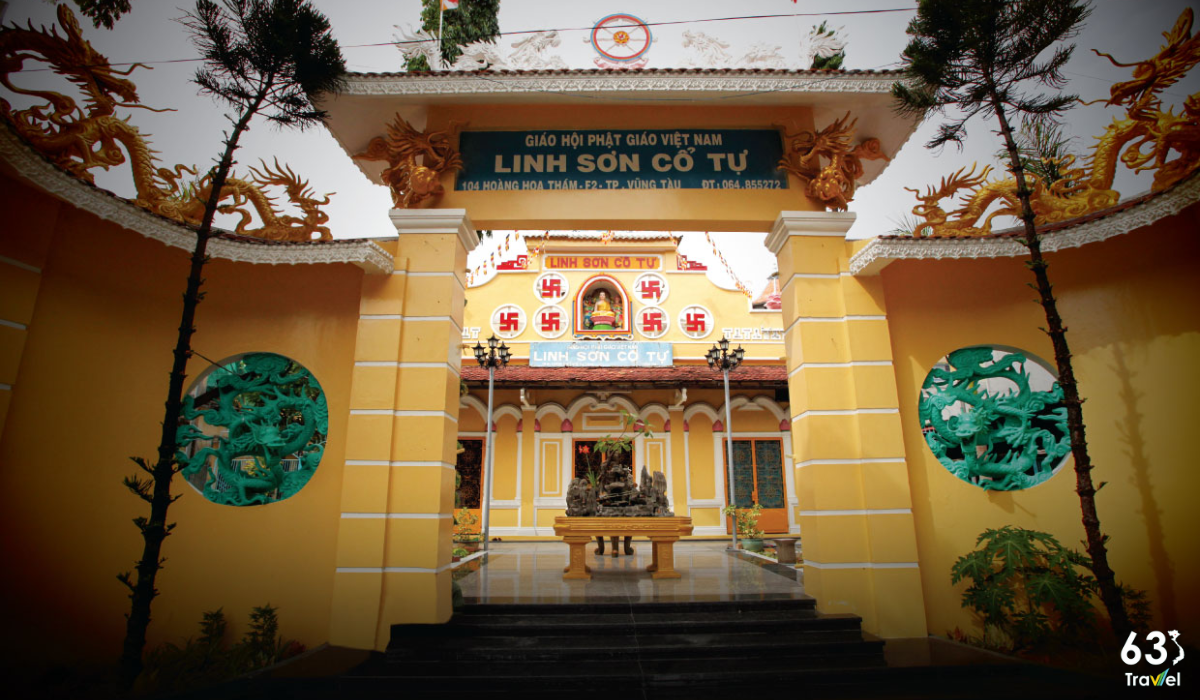
The temple has the oldest history in Vung Tau
Initially, the pagoda was made of bamboo with a yin-yang tile roof, but in 1948, Great Master Thich Tri Tinh - a famous abbot and the first Deputy Dharma Master, took over and expanded the pagoda. In 1959, Venerable Thich Tinh Vien moved the pagoda to the current land, where it is more spacious.
Linh Son Co Tu was recognized as an architectural and artistic relic on August 3, 1991 by the Ba Ria - Vung Tau Provincial Museum. The pagoda bears the mark of Buddhist architecture with exquisite dragon carvings. The main gate of the pagoda is decorated with twin dragon statues painted with pearls, painted in a characteristic yellow color. The space in the temple grounds is designed in harmony with yellow paint, lush green trees and a small lotus pond, bringing a feeling of peace and quiet.
Thang Tam communal house relic area (Thang Tam communal house, Lang Ca Ong, Ba temple)
Thang Tam communal house relic area is one of the prominent historical relics of Ba Ria-Vung Tau province. This is one of three ancient communal houses still intact on the Vung Tau peninsula, bearing a deep impression of local culture and history.
According to legend, after King Gia Long deployed three naval squadrons to protect Vung Tau seaport and fight pirates, they not only succeeded in repelling pirates but also supported people to reclaim land and establish villages. . The newly formed hamlets were named Thang Nhat, Thang Nhi and Thang Tam. Thang Tam communal house was built in 1820 and underwent restorations in 1835 and 1865.
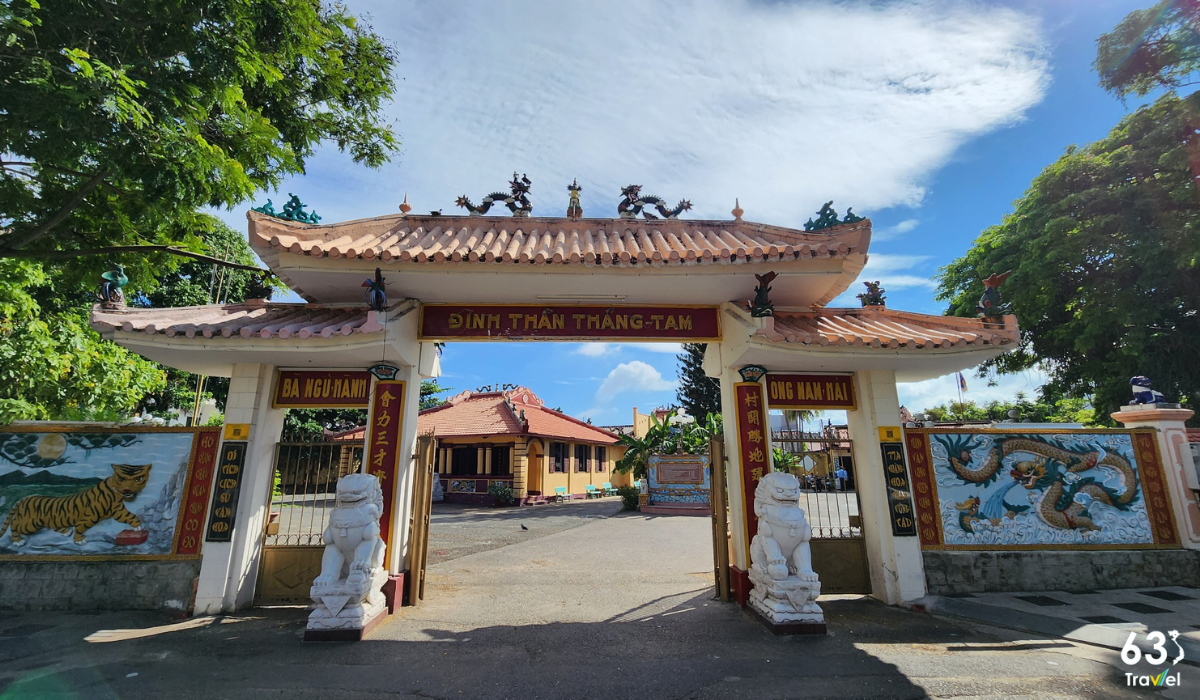
Thang Tam Temple - Famous spiritual destination in Vung Tau
This relic stands out with traditional Southern architecture, including the three-entrance gate, main communal house, Ong Nam Hai Mausoleum, Ba Ngu Hanh Temple, and areas such as the Vo ca stage and the assembly house. In particular, Thang Tam communal house also preserves 13 precious titles of gods and historical figures, increasing the cultural and religious value of this place. On March 25, 1991, Thang Tam temple was recognized as a national historical relic, affirming its important role in Vietnam's cultural heritage.
Bau Sen relic
Once a vast primeval forest with an area of 120 hectares and full of precious wood trees, this area has contributed greatly to many famous victories of our people and army, especially in the general offensive campaign to liberate the province. BA Ria Vung Tau. In 2007, to honor those resounding victories, Ba Ria - Vung Tau province inaugurated the Tam Bo victory monument at the Bau Sen relic site.
This nearly 2,460 m² construction is not only a historical symbol but also an important destination for future generations to learn about the nation's heroic days. Today, Bau Sen relics have become a popular tourist destination, where tourists, especially young people, have the opportunity to look back and deeply feel the heroic historical marks of their homeland.
Revolutionary historical relic Water factory station
The Vung Tau Water Plant Station Relic is an important historical site, marking the heroic resistance of the army and people of Vung Tau against the invaders. Initially built with materials such as stone, brick, lime, cement and wood, the structure is about 5x3.7x4m in size and once played an important role in protecting the strategic water supply system of the French army. .
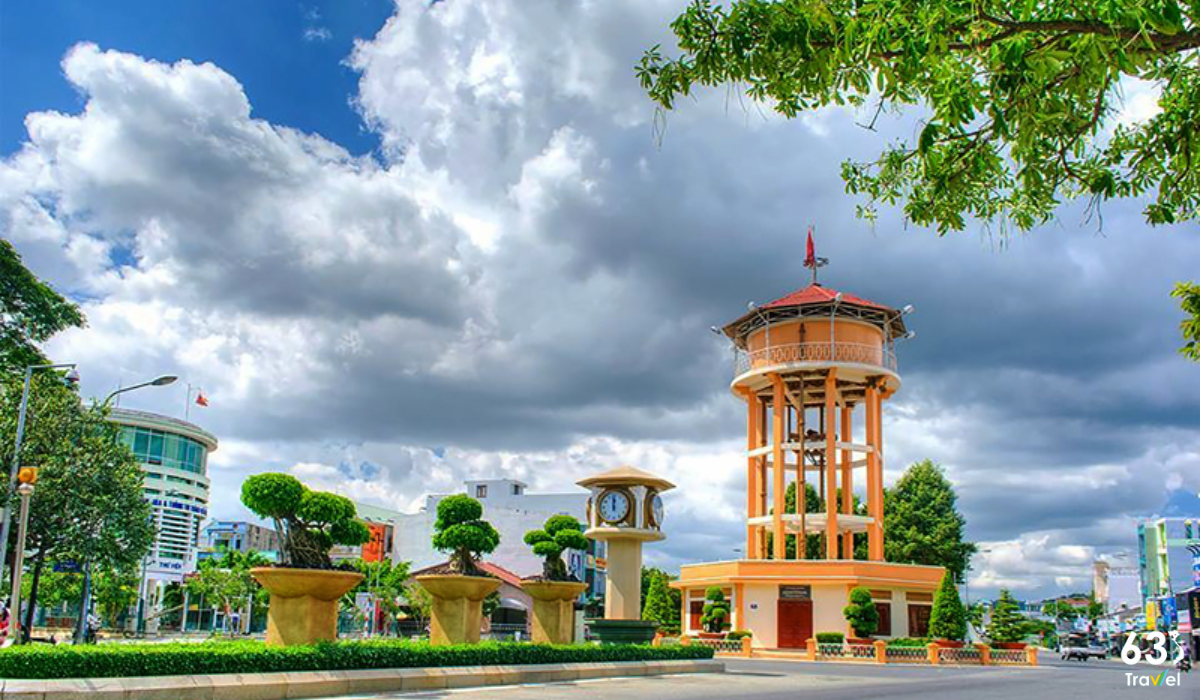
Hundred-year-old historical relic in Ba Ria city
During the resistance war against the French, the Water Factory Station became an important target and a witness of fierce battles in 1348, contributing to the great victory of Vung Tau's army and people. Recognized as a national monument on August 4, 1392, this monument is currently being preserved and restored to preserve its historical value and educate future generations, although it is currently facing with deterioration.
Historical revolutionary relic house number 86 - Phan Chu Trinh
The historic site of House No. 86 is a special address marking inspirational days in Vietnam's revolutionary history. Previously, this house was the residence of Pierre Chappuis (1878 - 1359), a French official who not only stood out for his philanthropy but also for his strong support for the people's struggle for independence. Vietnamese people.
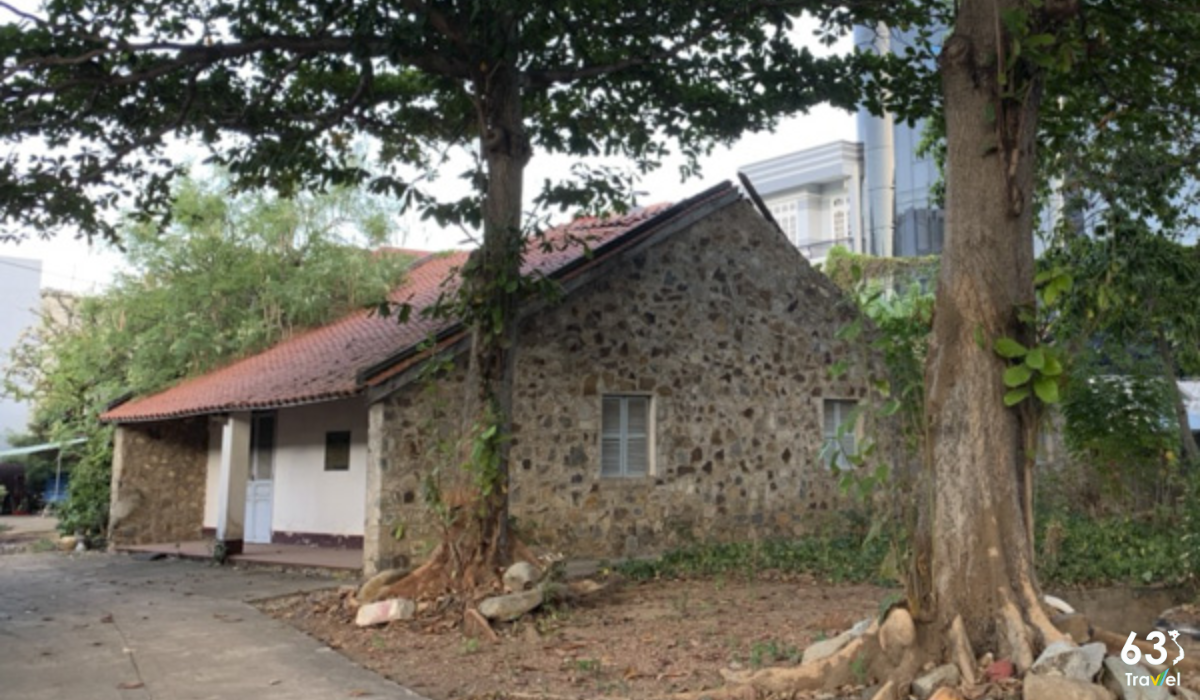
The house where the French mandarin hid revolutionary cadres
House No. 86 was built in classical French architecture, with blue stone walls and fired tile roofs, and became an important location for revolutionary activities. Pierre Chappuis took advantage of his house as a hideout and organized secret meetings of the Viet Minh. At the same time, in 1357, this house was also transferred to the Ba Ria - Long Khanh Provincial Party Committee.
Although Pierre Chappuis died in 1359, the relic of House No. 86 is still a symbol of his kindness and sacrifice for the Vietnamese revolutionary movement. On August 4, 1392, this relic was recognized as a national monument, honoring Mr. Chappuis's valuable contributions to the cause of the Vietnamese people's struggle for independence.
Phuoc Lam Tu Vung Tau relic
Phuoc Lam Pagoda is not only one of the oldest Buddhist centers but also a highlight of the history and culture here. Established in the 7th century, the pagoda has witnessed more than 200 years of development, preservation and promotion of its spiritual values.
The architecture of Phuoc Lam Pagoda is rich in history with a row of simple four-shaped houses and three majestic bell towers on the roof, creating a beauty that is both ancient and elegant. Despite many restorations, the pagoda still maintains the blend of tradition and modernity, making it a destination not to be missed.
The pagoda is also famous for its collection of precious treasures and ancient Buddha statues, including the statue of Shakyamuni Buddha, the Nam Hai Avalokiteshvara and the statue of Vishnu from the 7th century. These artifacts are not only valuable cultural heritage but also attract many Buddhists from all over to make pilgrimages.
Revolutionary historical relic "Cao Cao House" No. 18 Le Loi
The revolutionary historical relic site "Cao Cao" at No. 18, Le Loi Street, Ba Ria - Vung Tau City, not only marks important secret meetings of the Ba Ria - Long Khanh Provincial Party Committee during the period. anti-American imperialism, but also a unique architectural symbol. The house, with an area of 160m², was built in 1349 by Mr. Deloudet (French) and then transferred to many owners before becoming a revolutionary base under the management of Mr. Ba Tra in 1352. .
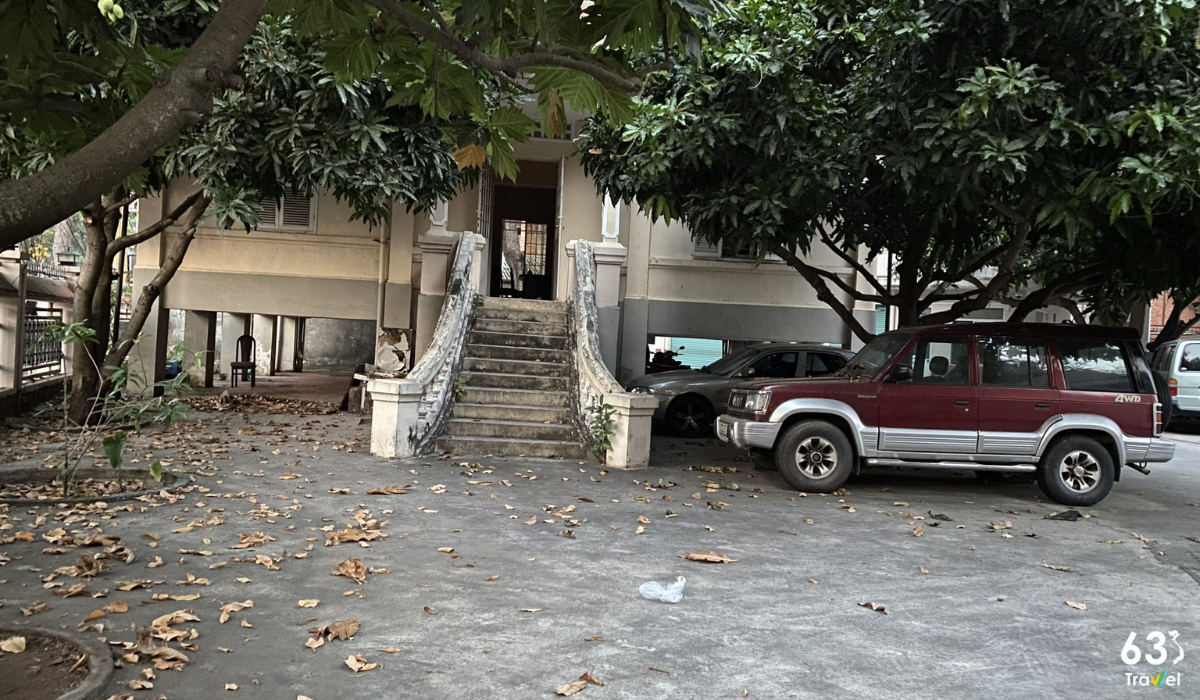
Revolutionary historical relic "Cao Cao" No. 18 Le Loi Vung Tau
With a special design including sturdy stone columns, "Cao Cao" is not only a place for strategic meetings but also a witness to important decisions in the struggle for independence. Considered the center of activities of patriotic soldiers, the house contributed significantly to the victories in the resistance war.
Today, although no longer a revolutionary center, "Cao Cao" still maintains its role as a symbol of resilience and the sacrifice of heroes. This relic is currently owned by the City Customs Department. Managed by Vung Tau, which was recognized as a national historical site on August 3, 1391, continues to be a destination to learn about the nation's heroic history.
>> Read more: Explore the oldest and newest churches in Ba Ria - Vung Tau at Christmas
Relics of the Viet Minh Committee headquarters in Vung Tau
The Viet Minh Vung Tau Committee headquarters relic site is an important symbol of the revolutionary movement in the South during the resistance war against the French colonialists. Built from 1308 - 1313, the project bears a strong impression of French colonial architecture, with a large design and strategic location near Bai Truoc beach.
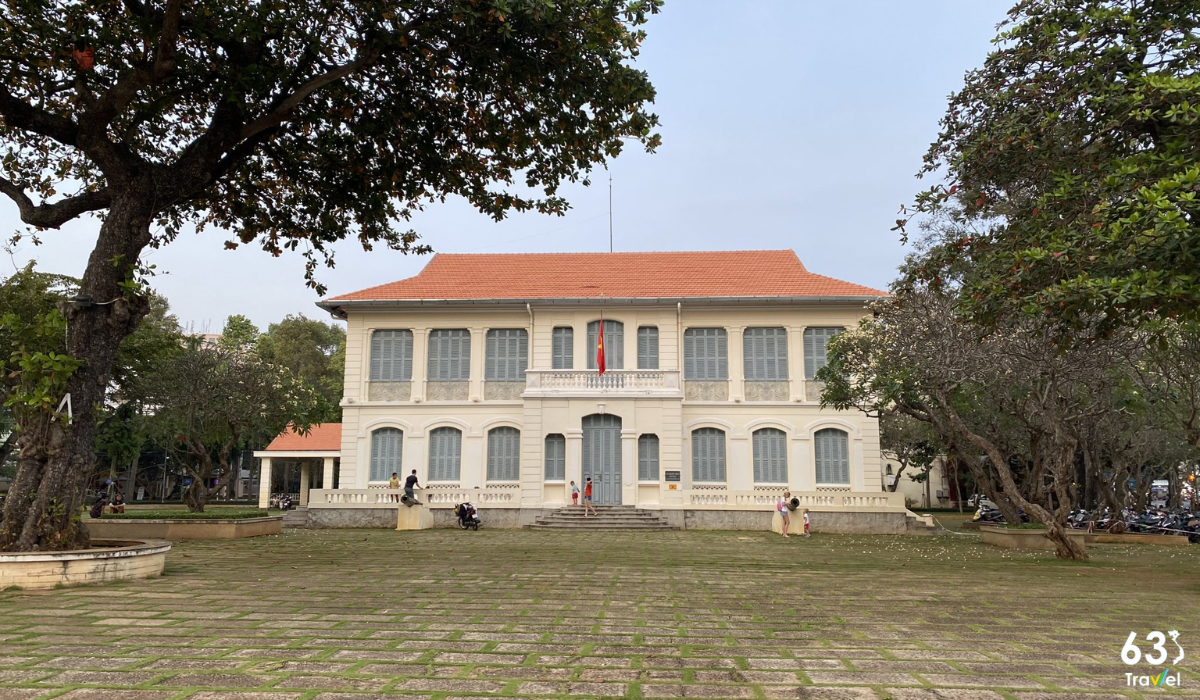
Historical - Revolutionary site Viet Minh Committee headquarters in Vung Tau
During the revolutionary period, especially during the August 1345 uprising, this headquarters became the center of vibrant activities of revolutionaries such as Nguyen Xuan Nhat, Ho Si Nam, and Nguyen Bao. Here, the Viet Minh Committee organized and led struggle movements, calling on the people of Vung Tau to stand up against French colonial rule and regain local autonomy.
Since the end of the war, the relic site has not only marked the years of heroic struggle but has also been renovated and preserved to become a prominent historical destination of Vung Tau city. On March 25, 1391, the Viet Minh Vung Tau Committee headquarters relic site was recognized as a national monument, continuing to be a testament to the resilient spirit and sacrifice of patriots during the war. anti-French war.
Long Phuoc Vung Tau Tunnel
Long Phuoc Tunnels is one of the important strategic symbols in the resistance war against French colonialism and American imperialism. Built in 1948, this tunnel system is not only a fortified network of trenches but also a testament to the creativity and courage of the army and local people. With a sophisticated design consisting of interconnected tunnels, this system is equipped with bunkers to store food, weapons, and combat fortifications, along with structures that serve the needs of survival in war conditions. hard.
The tunnel system, with a total length of about 3,600 meters, witnessed decisive historical moments, protected revolutionary forces and provided essential resources for the resistance. With great historical and military value, on January 9, 1990, Long Phuoc Tunnels was recognized as a national historical relic, becoming an important destination to remember the glorious days of the struggle for independence and freedom of the Vietnamese people.
Revolutionary historical relic Tam Nhung's House
The house of Mrs. Ho Thi Khuyen (also known as Tam Nhung's mother) was an important fulcrum during the August Revolution of 1945. Revolutionary historical relic Tam Nhung's house is where the Viet Minh Front Committee organized held secret meetings and was also a safe haven for revolutionary cadres.
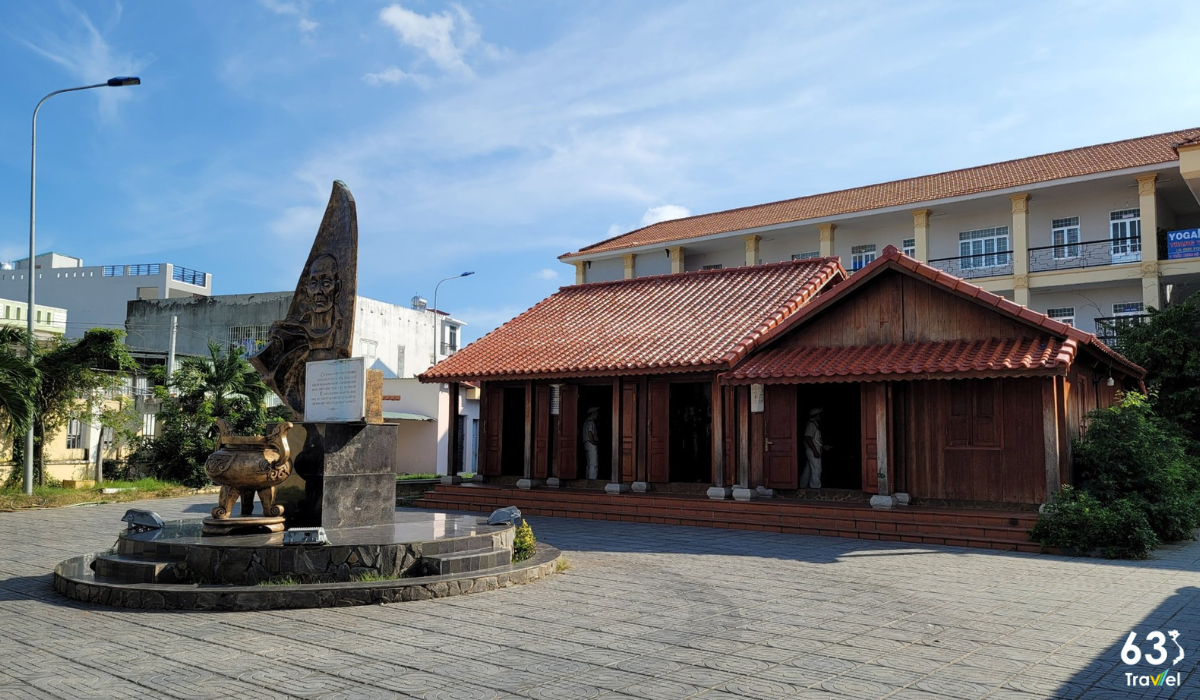
Revolutionary historical relic Tam Nhung's House
Mrs. Ho Thi Khuyen, born in 1910 in Ba Ria - Vung Tau, and her husband, Mr. Nguyen Van Nhung - are people dedicated to the ideal of national independence. When the uprising at Betel Garden failed, the couple actively participated in the Cochinchina resistance war. Their house became a center of revolutionary activity, with a secret bunker built in 1947, cleverly hidden under the shell of a water tank. This bunker is not only a place to protect officers from enemy pursuit but also a strategic place to discuss combat plans.
In order to ensure maximum safety, Ms. Khuyen and Mr. Nhung used many sophisticated camouflage methods, such as using fish scent to distract the enemy during a search. This house, as an important revolutionary base, was recognized as a national historical site on December 14, 1990, recognizing the sacrifices and great contributions of those who loved each other. country in the struggle for national independence.
Thus, the above article summarizes and shares with readers the historical relics in Ba Ria Vung Tau in detail. Hopefully, readers can visit and explore to understand the cultural and historical values of our nation.
Ho Chi Minh City 11993 view
Update day : 25/07/2024
On scorching hot days, everyone wants to immerse themselves in the cool, clear blue water. Coming to Dam Sen water park, you can dispel all the fatigue in life. Dam Sen water park with unbelievable ticket prices will be an ideal tourist destination for all tourists in the days when Saigon "lacks" storms. rain. The harmonious space combined with romantic rivers melts away worries and sadness and also provides energy for a new day. Coming to Dam Sen Water Park, you will immediately feel a green oasis located right in the heart of the city. With 36 modern water game equipment and a cool 3,000m2 wave pool, it promises to bring you many exciting feelings of relaxation. Modern 3000m2 water park with modern wave technology and 31 challenging games. Visitors will experience a cool space like being in a green oasis located in the heart of Saigon. Immerse yourself in healthy yet romantic waves to dispel the fatigue and burdens of life. Recharge your energy for a new working week. When coming to Dam Sen Water Park, you will experience the following games: Children's Pool, Wave Pool, Buoyant Slide 3 - Boomerang, Water Jet Massage, Super Speed - Kamizake, Tornado - Tornado,.. and many other games.
Ho Chi Minh City 4099 view
From January to December
Ho Chi Minh Opera House is located at 7 Cong Truong Lam Son Street, Ben Nghe Ward, District 1. It is one of the oldest buildings in Ho Chi Minh City following the flowery Western European architecture. Ho Chi Minh City Opera House is one of the typical architectural and cultural works of the city today. The front of the theater faces Lam Son Square and Dong Khoi Street. Next door are two large hotels, Caravelle and Continental. With a convenient location in the city center, the theater is not only a place to organize events but also an interesting tourist destination that attracts many tourists to visit and admire. Saigon Opera House is also an architectural counterpart to Hanoi Opera House. The authors of this ancient architectural building are architects Ernest Guichard, Eugène Ferret and Félix Olivier. Built in 1900 in the "flamboyant" architectural style of the Third French Republic. The facade of the opera house is clearly influenced by the art of the Petit Palais Museum that appeared in the same year in France. The inside is modernly designed with full equipment for sound and lighting. In addition to the ground floor, there are 2 additional floors with a capacity of up to 1800 seats. All decorative patterns, facade reliefs and interiors of the theater were painted by a famous artist in France to resemble the patterns of theaters in France at the end of the 19th century, extremely beautiful. The system of arched doorways with raised railings is designed with bold classical French architecture. Having gone through many historical events, up to now, the Ho Chi Minh City Opera House has been somewhat damaged. Until 1955, the theater was renovated but was used as the House of Representatives of the Republic of Vietnam government. And after 1975, the theater returned to its original function of organizing performing arts. On the occasion of 300 years of Saigon - Gia Dinh, in 1998, the Ho Chi Minh City government decided to renovate the opera house with the motto of preserving the original architectural style. Therefore, the embossed decorations and sculptures on the facade such as the statue of the goddess of art, the flower strings... have all been restored to their original state compared to nearly 100 years ago. Regardless of whether you are interested in learning about culture or simply admiring beautiful architectural works. Ho Chi Minh City Opera House will be your indispensable stop during your trip around Saigon. A beautiful architectural work that has contributed to adding elegance and charm to Ho Chi Minh City. In addition to visiting and admiring the ancient architecture of the Opera House, visitors can visit the Continental Saigon Hotel. One of the oldest hotels in Saigon, hundreds of years old. This place has welcomed many heads of state and politicians from all over the world.
Ho Chi Minh City 3603 view
From January to December
When mentioning Saigon, people often think of the most modern and bustling city in the country, but few people remember that Saigon also has many historical marks of its own. Cu Chi Tunnels are a clear proof of that. Only by going to the Cu Chi Tunnels can we partly understand the magnanimity of Vietnamese history. Cu Chi Tunnels is located about 70 km from Saigon center. This is the place where the transformation of Cu Chi's army and people during the 30-year resistance war to bring independence and freedom to the country is captured. The tourist area consists of 2 parts, 13km apart: Ben Duoc tunnels are located in Phu Hiep hamlet, Phu My Hung commune, Cu Chi district and Ben Binh tunnels are in Nhuan Duc commune and the main tunnel area. Cu Chi Tunnels have a length of up to about 250 km, from the "backbone" of the tunnel it spreads out like a spider web in the ground, including works: tunnels, trenches, embankments, fighting nests, food bunkers. , sleeping, meeting, kitchen, well, storage... The works are connected to each other or can be independent depending on the terrain. Some branches of the tunnel flow into the Saigon River so that in case of emergency, you can cross the river through Ben Cat base (Binh Duong). Inside the Cu Chi tunnels, it is dark and lacking in atmosphere. There are many places where visitors have to stoop to walk. Depending on the terrain, the tunnel can have up to 2 or 3 floors. The closest floor of the tunnel, about 3 meters from the surface, can withstand the weight of tanks and armored vehicles; some deeper places can withstand small bombs. Some hatches are designed into very flexible combat nests and sniper gun emplacements. Around the tunnel door, there are also many spike tunnels and mine pits. Thanks to its intricate and flexible architecture, this place sheltered many officials and people of Saigon during the resistance war against the enemy. Even though the enemy used many methods to destroy the tunnels such as: using water to break through, using an army of "rats", using sniffer dogs, etc. But all failed. In addition to the special historical relics of Cu Chi Tunnels, there are many other interesting fun activities here such as: national defense sports shooting, paintball shooting, swimming, boating on the lake or renting bicycles around. Tunnels. Going around the Cu Chi tunnels tourist area is also an experience worth trying. Here the air is fresh, not noisy like the inner city of Saigon, giving anyone who comes here a feeling of relaxation.
Ho Chi Minh City 3630 view
From January to December
Dai Nam tourist area began construction in 1999 and in 2008, it officially opened to welcome visitors. This is a tourist area that has recorded many records such as the tourist area with the largest area in Southeast Asia, the longest wall, the largest temple, the longest artificial mountain, the largest artificial sea, and the largest garden. The first open design animal in Vietnam. Divided into 5 main areas including racetrack, temple, zoo, artificial beach, entertainment area with games classified by popular level, thrills and adventurous exploration. Dai Nam racetrack area is the first complex project in the sports sector in Vietnam with a combination of 5 types: horse racing, motor racing, go-kart, jet-ski and fly-board performance. . All racetrack infrastructure is built according to safety standards, especially go-karts (the basic step to participate in professional F1 racing) appearing for the first time in Vietnam. will certainly attract the curiosity of tourists. Another highlight of Dai Nam tourist area is Dai Nam Temple, which is 9 hectares wide and has the main door facing the Bodhisattva Avalokiteśvara Garden. This is also where national festivals take place, notably the celebration of the United Nations Day of Vesak - VESAK and special performances on major occasions. In addition to Dai Nam Temple, this tourist area also owns an open zoo model that is recognized as the first model to appear in Vietnam with a diverse range of species, including rare and endangered animals. species such as Indochinese tiger, Ca-Tong deer,... Dai Nam tourist area also owns a truly impressive artificial beach, attracting a large number of families to bring their children here to play and immerse themselves in the clear blue water on holidays or weekends. In addition to the sea area, there are also castles surrounded by sea water along with small islands and wave generating systems that bring the most authentic feeling to visitors like being at the natural sea. Tourists who come to Dai Nam tourist area will hardly miss the entertainment area with more than 40 games at many different levels to meet the entertainment needs of all people and all ages. The large area of the game area along with the diverse number of types of games here promises to bring you the most wonderful moments of rest here.
Ho Chi Minh City 4016 view
From January to December
Ben Thanh market is located in the center of District 1, the most crowded and magnificent area in Saigon. Located near many famous Saigon tourist attractions such as the Independence Palace, City Post Office, City Theater... and many high-end 5-star hotels, Ben Thanh market attracts many tourists. Ben Thanh Market was formed in the mid-19th century. Through the ups and downs of history, this market has long become a symbol of the vibrant trading culture of Saigon in particular and Vietnam in general. Along with the economic and tourism development of Ho Chi Minh City, this market is also increasingly famous and especially attracts a large number of foreign tourists to visit. Vietnamese people are no strangers to crowded, bustling markets. But for foreigners, this is a very unique cultural feature. Therefore, foreign tourists love to go to the market to shop for souvenirs and try Vietnamese specialties. Gradually, Ben Thanh became a prominent symbol of Saigon, making everyone who comes to this city want to visit once. Ben Thanh Market was originally built in the 17th century near the Ben Nghe River to welcome tourists and soldiers into Gia Dinh Citadel. That is also the reason why the market was named Ben Thanh (river wharf + citadel). The market is made of brick, wood and thatched roof. Ben Thanh market in the past was very crowded and bustling, with boats and boats busy day and night. After a long period of use, the market gradually deteriorates and is at risk of collapsing at any time. Therefore, the French rebuilt it and expanded it to a larger scale after filling in a muddy pond named Bo Ret. Since 1912, it took another 2 years for the French construction contractor Brossard et Maupin to complete this project. The old architecture has since been preserved to this day even though Ben Thanh market underwent a major renovation and repair in 1985. Ben Thanh Market has 4 main gates and 12 side gates. Each main gate is located on a different street and displays many popular items for visitors to shop: South gate of Ben Thanh market: South gate is located on Le Loi street, opposite Quach Thi Trang park, this is the main gate of the market. The highlight of this market gate is the famous 3-sided clock tower. The entrance attracts many visitors with stalls selling all kinds of goods, mainly fabrics and dry foods. East Gate of Ben Thanh Market: East Gate is located on Phan Boi Chau Street, a paradise for cosmetics enthusiasts. The stalls here sell a variety of body, skin and hair care products. West gate of Ben Thanh market: West gate is located on Phan Chu Trinh street, this gate has many stalls selling shoes, crafts and souvenirs. North gate of Ben Thanh market: North gate is located on Le Thanh Tong street, this gate sells many types of fresh flowers and tropical fruits. During the day, Ben Thanh market bustles with stalls offering a variety of goods, including textiles, souvenirs, handicrafts, fresh produce, seafood, spices... Atmosphere This place has the true nature of a typical Asian market, bustling and rustic. Ben Thanh Market at night is still crowded but somewhat more peaceful. The stalls mainly sell food with local snacks and drinks. There are also some shops selling clothes, accessories and souvenirs. Bright torches and the sweet aroma of countless Vietnamese specialties are what attract tourists.
Ho Chi Minh City 4295 view
From January to December
Notre Dame Cathedral or Saigon Notre Dame Cathedral is a name that people shorten for convenient use. The full name of this project is the Cathedral Basilica of the Immaculate Conception. The church is 91m long, 35.5m wide, and the main dome is 21m high. The two bell towers on both sides are nearly 57m high. Saigon Notre Dame Cathedral was built with classic French architecture, designed by talented architect J.Bourard. The outside space of the church is very large and airy, the inside is majestic and ancient. The history of Saigon Notre Dame Cathedral began with the French war of invasion at the end of the 19th century. The French government at that time wanted to build a large church to serve the community and religious activities for the government. French government and army. The first church was located on Ngo Duc Ke Street but was too small so the French Admiral Bonnard decided to build a larger church. Construction of this Saigon Cathedral began on March 28, 1863. After two years, the church was completed. In 1895, the French built two more bell towers. Around the tower there are six small bronze bells. At the top of each tower is a cross that is 3.5m high, 2m wide and weighs 600kg. At this time, the height of the building, from the ground to the highest point, was 60.5m. The French also cast a bronze statue of Pigneau de Behaine (also known as Bishop Adran) holding the hand of Prince Canh, the eldest son of King Gia Long. This statue is located in front of the church. In 1945, the statue was destroyed but its base still remains. In 1959, Bishop Joseph Pham Van Thien ordered the statue of Our Lady of Peace from Rome. On February 7, 1959, Cardinal Agagiianian came from Rome to solemnly inaugurate the statue. Since then, the church has been called Saigon Notre Dame Cathedral by the people. Saigon Notre Dame Cathedral was built with the neo-Romanesque Revival (or Neo-Romanesque) architectural style. This was a building style popular around the mid-19th century, inspired by 11th and 12th century Romanesque architecture. Buildings in this style tend to feature arches and portholes. simple disign. During the construction of Saigon Notre Dame Cathedral, all materials from cement, steel to screws were brought from France. The exterior of the building is made of bricks produced in Marseille. The advantage of this type of brick is that it is bare, not plastered, not mossy, and still retains its bright pink color after decades. The entire cathedral has 56 stained glass windows produced in Chartres province (France). The foundation of the cathedral is specially designed to bear 10 times the weight of the entire architectural volume. And a very special thing is that the church does not have fences or walls like the churches around Saigon Gia Dinh at that time. The interior of the cathedral has two main rectangular rows, with six rows on each side representing the 12 apostles. The altar of Saigon Notre Dame Cathedral is made of monolithic marble with six angels carved into the stone. The pedestal is divided into three cells, each cell is a sculpture depicting a relic. The walls are decorated with 56 glass windows depicting biblical characters or events, 31 round rose figures, 25 multicolored bulls-eye windows combined with beautiful images. All lines, edges, and patterns follow stately and elegant Roman and Gothic forms. However, out of these 56 glass doors, only 4 are still intact. The other glass doors were repaired in 1949 because they were destroyed during the war. The original design had two bell towers that were 36.6m high, had no roof and only had a narrow staircase of about 40cm. The interior is dark and the floor is lined with small pieces of wood. In 1895, the church built two more roofs to cover the 21m high bell tower designed by architect Gardes, for a total of 57m high bell tower. All six bells are hung on two bell towers. This bell was made in France and brought to Saigon in 1879. The bell is controlled electronically from below. On weekdays, Saigon Notre Dame Cathedral only rings at 5:00 a.m. and 4:15 p.m. On holidays and Sundays, the church often rings three bells. 6 bells ringing at the same time will have a very loud sound, you can even hear the bell from 10km away. Between the two bell towers is a very large clock. It was produced in 1887 and weighs 1 ton. Even though it is more than a hundred years old, the clock still operates very accurately. Paris Commune Square is located between Notre Dame Cathedral and Nguyen Du Street. In the center of the main square is where the statue of Our Lady of Peace is located. This is where visitors often stop to drink coffee, take photos, and watch pigeons. Especially on weekend mornings, many young people gather here to chat and have fun together. The image of Notre Dame Cathedral has long become a representative part of the magnificent land of Saigon. Near the church there is also the Independence Palace and the city Post Office. You can combine visiting these three famous destinations to explore Saigon to the fullest.
Ho Chi Minh City 3738 view
From January to December
Lang Le Bau Co relic site is located in Tan Nhut commune, Binh Chanh district, Ho Chi Minh City. Lang Le Bau Co is associated with the resistance war against the French invasion in 1948 with major battles that went down in history. Lang Le Bau Co relic was recognized as a city-level historical relic in 2003. The reason it is called Lang Le Bau Co relic area is because the name of Lang Le Bau Co relic area was given by local people. The hamlet was established next to the interlaced canals and rivers. Lang Le Bau Co is located inside a large field with many shrimp, crabs, and fish. Along with many species of birds such as mallards, storks, teal, nuthatches, gongs, partridges, herons, and red armpits come to feed here. Therefore, Tan Nhut people call it by the familiar and rustic name Lang Le Bau Co. Lang Le Bau Co relic is considered the gateway to move to the center of Vuon Thom base and attack the enemy headquarters in Saigon. Previously, Lang Le Bau Co relic area was originally a field of overgrown reeds. On April 15, 1948, the French colonialists sent 3 thousand soldiers and many modern weapons to simultaneously attack the Lang Le Bau Co area to destroy the Vuon Thom base. At that time, the revolutionary armed forces in Lang Le - Bau, because of their small force and rudimentary weapons, had the help of local people along with the advantage of terrain. After just over half a day of fighting, it turned to attack, causing the French army to suffer a large number of casualties. The victory at Lang Le Bau Co killed 300 enemies, captured 30 mercenaries, and destroyed many machines, military vehicles, and guns of all kinds of the enemy. However, on our side, there are many officers and soldiers who heroically sacrificed their lives at a very young age. On October 14, 1966, in Lang Le, the Republic of Vietnam Army Ranger Battalion was destroyed by tourist militia. Lang Le Bau Co relic site has great historical significance for the people of Saigon in particular and the whole country in general. Faced with hatred for the French colonialists, Lang Le Bau Co's army and people fought a war of great historical significance that opened the door for our side and the enemy. For our side, the battle opened the door to heroism in a strong resistance position. As for the enemy, they had to retreat into a strategic position and were destroyed. The French colonialists could no longer form a strategy to defeat the Viet Minh. Moreover, at Vuon Thom base, Lang Le Bau Co also took place a determined battle to protect our base and destroy all sabotage plans of the enemy. Lang Le Bau Co relic area, after the Dong Khoi movement in 1960, was also a logistics and springboard for the armed forces to liberate Long An - Saigon - Gia Dinh. To commemorate the sacrifices of our compatriots and soldiers, in 1988 Binh Chanh district built a historical building in Lang Le Bau Co land with an area of 1000m2. Source: Ho Chi Minh City Electronic Information Newspaper
Ho Chi Minh City 10552 view
Hoc Mon District Palace is located at No. 1, Ly Nam De Street, Hoc Mon Town, (next to the District People's Committee headquarters) and is the place where many outstanding fighting events have been recorded throughout the long history from 1885 to the Southern days. Complete liberation of the People of 18 Betel Garden Villages. After defeating Chi Hoa Fort, the French colonialists built a 3-storey wooden house here to use as a military post. When Tran Tu Ca took office as Governor of the Palace, he used the Station as the Palace of Binh Long district. Originally a cunning drunkard of the French colonialists, Tran Tu Ca was led by a group led by Mr. Phan Van Hon (Quan Hon) and Nguyen Van Qua (Chanh Lanh Binh) of nearly 1,000 insurgents who came to burn the District Palace, captured and head cut off in the middle of the market. That was February 8, 1885, At Dau Tet. Afterwards, Hoc Mon District Palace was rebuilt with a blue stone foundation, brick walls, and a defense system from the upper floors to the fence. The architecture is similar to the Military Fort, so the locals call it Hoc Mon Fort. Tran took over from Tran Tu Ca as Governor of Ngon district, moving to Tra District and then Tho District. This was a long period of time when the people of the Hoc Mon region suffered from many cruel and despicable scenes from the French colonialists and their oligarchic henchmen mentioned above. With the indomitable tradition of Hoc Mon people. On June 4, 1930, around 6 a.m. in front of the District Palace, hundreds of Hoc Mon people protested demanding "abolition of poll tax, reduction of license and market taxes, and granting land to poor farmers." Tra District invited the leaders into the Palace to negotiate, but they cunningly arrested them, including Mr. Le Van Uoi (Secretary of Tan Thoi Nhi Commune), who was the leader of the protest. People were undaunted and fiercely demanded that Tea District release those detained. The protest group became more and more crowded, the fighting spirit spread somewhat, causing Tra District to give in. On the one hand, they released the detained people, on the other hand, they called the officials in Saigon for help. 2 hours later, the struggle was led by two men, Blachole and Nobbot, who opened fire on the protest group, causing many casualties. But the most impressive historical event at Hoc Mon District Palace was the Southern Uprising on November 23, 1940. Hoc Mon Fort is very solid, built of green stone like a fortress, about 15 meters high, has a gun emplacement and a defense system with battlements guarded by a platoon of green soldiers. On November 22, 1940, France reinforced one more platoon to deal with the situation. On the afternoon of November 22, 1940, Mr. Do Van Coi's army broke into the town, disguised as civilians, ambushed behind the Station waiting for orders to rob the Station. Another army wing has the task of destroying bridges, cutting down trees blocking roads, and occupying offices and houses... The army wing from Phuoc Vinh An, Tan Thong, Tan An Hoi, Tan Phu Trung is led by Mr. Pham Van Sang and Dang Cong Binh commanded, started from Ben Do hamlet, attacked the house, killed 1 person, collected 4 guns, and took control of the situation here (Tan Phu Trung). Immediately this army was ordered to pull back to Hoc Mon. The Long Tuy Thuong army was commanded by Mr. Bui Van Hoat. The army of General Long Tuy Trung was commanded by Mr. Do Van Day and Le Binh Dang. At around 24:00 on the night of November 22, 1940, the sound of artillery fire had not yet been heard in Saigon. After consulting, the army commanders united to attack the enemy's post. Immediately the troops headed straight to Fort Hoc Mon, where District Chief Bui Ngoc Tho resided. Two insurgents named Nghe and Kinh volunteered to enter the front gate and sacrificed their lives. Insurgents from all directions rushed into the Fort like water bursting its banks. Faced with the power of the insurgents and the masses, the soldiers in the Station no longer had the spirit to resist and fled in disarray. The insurgents completely occupied the inside of the station, but upstairs, the enemy still stubbornly used guns to shoot sporadically, at the same time calling Saigon and Thu Dau Mot for emergency help. Because he was eager to capture the name of Tho District, comrade Do Van Day climbed up to the upper floor of the Station by clinging to the gutter. Halfway up, he was hit by bullets, the comrade fell and died later. The battle was at a standstill when enemy reinforcements arrived. Unable to hold out, the insurgents withdrew from the town, dispersed to the villages, the armed forces withdrew to Ben Do hamlet (Tan Phu Trung) and then moved to My Hanh hamlet (Duc Hoa). Although the attack on Hoc Mon Fort (later called Hoc Mon District Palace) failed, it left a deep impression in the hearts of all civilians admiring the courage of revolutionary soldiers in the fight against colonialism. steal the country. During the historic Ho Chi Minh campaign, at 7:00 a.m. on April 30, 1975, Hoc Mon town was completely liberated, the National flag fluttered above the District Palace, where District Chief Nguyen Nhu Sang and his gang sai has been running away since last night. Today, Hoc Mon District Palace is chosen as the District Museum, where many documents are displayed, illustrating the ups and downs of historical periods as well as the revolutionary fighting spirit of the army and people in Hoc Mon district over the past two years. resistance war against French colonialism and American imperialism. A monument placed in front of the Hoc Mon District Palace relic represents the indomitable sacrifice of the army and people of 18 Betel Garden Villages, recognized as a national historical and cultural relic. Source: Hoc Mon District People's Committee
Ho Chi Minh City 6284 view
The US Embassy relics, also known as the "White House of the East", are the origin of sinister military and political plots aimed at long-term annexation of Vietnam. The relic site is a 5-storey building built Built in modern architecture, located at the corner of Mac Dinh Chi - Le Duan Street, Ben Nghe Ward, District 1, Ho Chi Minh City, on a plot of land nearly 5,000 square meters. Previously, the US embassy was located at 39 Ham Nghi Street. At around 10:00 a.m. on March 30, 1963, the US embassy on Ham Nghi Street was hit with explosives by the F21 Commando team, collapsing three floors: 1, 2, 3, so the US decided to rebuild it. Construction began on the building in 1965, most of the materials and construction machinery were transported from the US, under the control of American engineers. According to the design, the building is surrounded by 7,800 Taredo stones that can withstand mines and artillery shells. The main door is equipped with thick steel, the other doors are blocked by a special thick bulletproof layer. All doors use automatic systems, including iron doors blocking the way to the upper floors. Inside the building there are 140 rooms with 200 staff serving day and night. In addition, next to the building is also built an additional row of houses called the "Norodom" area exclusively for C.I.A. employees. When inaugurated, the building had only 3 floors. At the end of 1966, two more floors and a terrace were built to serve as a landing place for helicopters. Surrounding the building is a 3m high wall, at both ends of the wall close to Le Duan Street, 2 high blockhouses are built, guarded day and night. The Embassy was completed in September 1967 with a defense system such as a fortress with 60 guards, a bomb shelter, and a radar screen system to control the facade. Immediately after the building was completed, on September 24, 1967, thousands of students flocked to the gate of the US Embassy to fight for "America to stop bombing the North", "America to go home" and issued a notice denouncing the US for "trampling and seriously violating the right to self-determination of the Southern people". But the outstanding event that happened at the US Embassy was the battle of the City Rangers during the General Offensive and Uprising in the Spring of 1968. The target of attacking the US Embassy was added on January 24, 1968 by Ngo Thanh. Van is in charge of general affairs. Ranger Team 11 took on this important mission, including captain Ut Nho (military region reconnaissance captain) and soldiers: Bay Truyen, Tuoc, Thanh, Chuc, Tran The Ninh, Chinh, Tai, Van, Duc, Cao Hoai Vinh, Mang, Sau and 2 drivers: Tran Si Hung and Ngo Van Thuan. Another equally humiliating event for the US Embassy was the chaotic escape that occurred on April 29 and 30, 1975 by the US and its accomplices. Faced with the rapid attack of the Vietnamese army and people in the historic Ho Chi Minh campaign, over 1,000 Americans and more than 5,000 pro-American Vietnamese jostled, pushed, and kicked each other to compete for a place on the terrace of the building. building to be rescued by helicopter. This relic was granted a certificate of recognition by the Ministry of Culture on June 25, 1976. Currently, the US Embassy building has been demolished and a new consulate in Ho Chi Minh City has been built, but next to it is a memorial stele forever remembering the achievements of the special forces soldiers who died in the battle. . Source: Ho Chi Minh City Youth Union
Ho Chi Minh City 6212 view
Nga Ba Giong relic is a revolutionary historical relic located in Hamlet 5, Xuan Thoi Thuong commune, Hoc Mon district. Surrounded by three roads: Phan Van Hon, Nguyen Van Bua and Provincial Road 19. Nga Ba Giong relic site is a memorial site for historical events in two wars against foreign invaders. Recognized as a national historical site in 2002. Giong Junction (also fully known as Giong Bang Lang Junction) is located in Xuan Thoi Tay village, part of 18 old betel garden villages formed from 1698 to 1731. For a long time, Giong Junction is a place with a folk name that has entered the history of the hometown of 18 betel garden villages of Hoc Mon - Ba Diem. Legend has it that in the past, this place was a relatively high land and a place where many linden trees grew, so this place got its name from there. After the Southern Uprising (November 23, 1940) failed, the French colonialists increased their repression and fierce terror against the revolutionary movement in the Hoc Mon - Ba Diem region. They set up three shooting ranges in Hoc Mon to kill Party leaders and patriotic comrades from their hometown of Hoc Mon and surrounding areas. Giong intersection is the third shooting range to record the heinous crimes of the French enemy and his henchmen against the people of Hoc Mon. Learning from the experience of 2 previous shooting ranges (1 at the old theater in the center of Hoc Mon District, 1 next to the well behind Hoc Mon Hospital today), they executed public shootings, forcing people to come and watch for the purpose of intimidation. revolutionary spirit of Hoc Mon people. But that firing squad backfired. The Hoc Mon people witnessed with their own eyes the cruelty of the French colonialists and the noble sacrifices of the communist soldiers, so their patriotic fire flared up even more fiercely. . For this third shooting range, they did not dare to build it near the center of the District anymore, but moved it to the Giong Junction area as a desolate, sparsely populated area to avoid people's resistance. Here, they built a shooting range with a solid mound of land 12m long, 2.2m high, in front of which were planted 6 shooting posts, each 1.7m high, the shooting direction facing the field (Ba Tram Lac). In 1941, here they secretly executed many times without letting the people see, hundreds of communist soldiers and patriots were killed by them. With the extremely sacred historical significance of Giong Junction, the place that marked the barbaric crimes of the French invaders, the place that demonstrated the indomitable fighting will and noble sacrifices of our comrades and compatriots later on. the Southern Uprising (November 23, 1940); After the complete liberation of the South (April 30, 1975), Hoc Mon district quickly restored and embellished the Nga Giong Junction revolutionary historical relic site to educate traditional generations of youth. This place has become a tourist attraction and a place to organize traditional festivals during major annual holidays of Hoc Mon district and the city, especially the anniversary of Southern Uprising Day (November 23). Currently, with the consent of the city, the district is renovating and building Giong Junction into "Giong Junction Martyrs' Memorial Area". Source: Hoc Mon electronic information portal
Ho Chi Minh City 5988 view
Nha Rong Wharf is one of the historical relics associated with the great President Ho Chi Minh's path to national salvation. Nha Rong Wharf or Ho Chi Minh Museum started out as a major commercial port of Saigon. This trading port is located on the Saigon River and was built in 1863, and more than 2 years later, in 1864, this Nha Rong was completed, on the area near Khanh Hoi bridge. Construction of Nha Rong began on March 4, 1863, by the "Sea Shipping Company" to build a store to serve as a residence for the General Director and a place to sell train tickets. The roof is decorated with a dragon image, in the middle instead of a pearl is a badge with the image of "Horse head and anchor". The "Horse Head" insignia refers to the time when in France, this company specialized in road transport with horses pulling carts, while the "Anchor" symbol symbolizes ships. In 1919, the company was allowed to build a wharf with reinforced cement but could not do so. It took until March 1930 to complete the new wharf, which had only one wharf but was 430m long. In 1955, after the French colonialists failed in Vietnam, Saigon Trade was transferred to the southern government of our country to manage. The government restored the roof and replaced the two old dragons with two other dragons with heads facing outward. With a construction area of nearly 1,500 square meters, the remaining area is a green garden with cool air and a romantic setting of more than 400 precious trees from all over the country gathered here to show off their beauty and fragrance, especially especially the banyan tree of the late General Secretary Nguyen Van Linh and the bodhi tree of the President of India. In 1965, Nha Rong was used by the US military as the headquarters of the US Military Aid Receiving Agency. In 1975, after the country was unified, Dragon House, the symbol of Saigon port, was managed by the Vietnam Seaway Department. Nha Rong Wharf is currently the Ho Chi Minh Museum, Ho Chi Minh City Branch, one of the museum branches and souvenirs about President Ho Chi Minh in the country. Because here, on June 5, 1911, young man Nguyen Tat Thanh (later Ho Chi Minh) boarded a train to work as a kitchen assistant to have the opportunity to go to Europe. Next was the day Uncle Ho left to find a way to save the country in Vietnam. Nha Rong Harbor is a place to preserve many priceless documents and artifacts to help future generations better understand the life and great revolutionary career of the Father of the Nation. The museum is built into 12 galleries with about 170 data, images and artifacts. Not only that, this is also an address for people to come and learn about the life and revolutionary career of Uncle Ho. Nha Rong Wharf is also a destination that attracts millions of domestic and international tourists. From the above great values and meanings, Nha Rong Harbor deserves to be a national historical relic that we need to preserve, honor as well as propagate and promote to friends in five continents. Nha Rong Wharf will forever be a great pride of the entire nation. Source: Department of Cultural Heritage
Ho Chi Minh City 5203 view
The Steel Wire Bot relic includes 3 separate houses, Western-style architecture, brick walls, tile roofs, located on high land in Tang Nhon Phu A ward, district 9, Thu Duc city. Steel Wire House was built a long time ago. According to elders over 80 years old, they saw the Steel Wire house when they were young. Before 1945, the Steel Wire House was formerly known as the Steel Wire House because it was built to serve as a news transmitting and receiving station for the French. The station is designed to consist of three separate houses with 'western' style architecture with three antenna columns, the tallest of which is over 70 m. The project was designed by two Frenchmen, Hermall and Stéru, to serve the invasion of the French colonialists before 1945. The steel wire is a house with one ground floor and one floor, with many windows facing out in four directions. On the left side of the house there are two stairs leading to the first floor. The strangest thing is that in Steel Wire Bunch there is a secret cellar used to lock up and torture people they consider 'rebellious'. The tunnel has only one vent at the top. The mouth of the tunnel is small (0.4 m2) just large enough for a person to stand upright and enter the tunnel. In 1945, when Japan staged a coup to oust France in Indochina, the Steel Wire House was occupied by Japanese fascists. Not long after, the Japanese fascists were defeated, the French colonialists returned and the Steel Wire House belonged to the French again. When retaking the Steel Wire House, the French colonialists took down the antenna column (leaving only one column) and built two more brick houses with high floors, one for the commander named Pi-rolet and the other. The remaining room is reserved for French soldiers to guard. Since the day they took over Steel Wire, the French army has turned this place into a prison, arresting, besieging, torturing, and interrogating the people of the heroic Tang Nhon Phu village and those they suspect of being involved. , providing supplies to revolutionary soldiers. Here, during the nine-year resistance war against the French colonialists, French soldiers interrogated and tortured countless people as well as resilient revolutionary soldiers. They arrested and brutally used all methods of interrogation. There are prisoners who suffocated to death because the cellar was overcrowded and there was no oxygen. Many other people, regardless of age, young or old, male or female, whenever they were suspected by them, they had to stand in line so they could shoot them and throw their bodies into the Cau Ben Noc River. More brutally, they also used machetes to decapitate, threw the body into the river, the head was impaled on a stake, and formed a long line in front of the steel wire fence to 'expose the crime', preventing patriots from standing up. Being surrounded by steel wire during nine years of resistance against the French colonialists was a living hell for many innocent people. The Steel Wire Basket Relic was recognized by the Ministry of Culture, Sports and Tourism as a national historical and cultural relic on January 18, 1993. Source: Tang Nhon Phu A Ward Youth Union
Ho Chi Minh City 4920 view
141, Nguyen Hue, District 1, Ho Chi Minh, Vietnam
Tourism Association Ho Chi Minh City
Just words : Contact
Discount 0% Travelviet VIP
Final price : Contact
39-39a- 41, Thu Khoa Huan, District 1, Ho Chi Minh, Vietnam
Tourism Association Ho Chi Minh City
Just words : Contact
Discount 0% Travelviet VIP
Final price : Contact